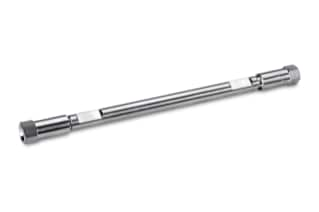
|
Chemistry |
HILIC |
|
Separation Mode |
Hydrophilic Interaction (HILIC) |
|
Particle Substrate |
Silica |
|
pH Range Min |
1 pH |
|
pH Range Max |
5 pH |
|
Maximum Pressure |
6000 psi (415 Bar) |
|
Endcapped |
No |
|
Silanol Activity |
High |
|
Particle Shape |
Spherical |
|
Particle Size |
5 µm |
|
Endfitting Type |
Waters |
|
Pore Size |
100 Å |
|
Format |
Column |
|
Surface Area |
330 |
|
System |
HPLC |
|
Particle Technology |
Silica |
|
USP Classification |
L3 |
|
Inner Diameter |
2.1 mm |
|
Length |
100 mm |
|
UNSPSC |
41115709 |
|
Brand |
Atlantis |
|
Product Type |
Columns |
|
Units per Package |
1 pk |
Atlantis Silica HILIC Column, 100Å, 5 µm, 2.1 mm X 100 mm, 1/pk
Atlantis HILIC Silica columns are used in combination with high organic mobile phases (>80% acetonitrile) to provide retention of analytes that are simply too polar to be retained by reverse-phase chromatography. HILIC separation mechanisms provide orthogonal analyte selectivity compared to traditional chromatographic reversed-phase approaches.
Due to their hydrophilic nature and net positive charge at acidic pH, highly basic polar analytes are exceedingly challenging to retain and separate using reversed-phase chromatography. The Atlantis Silica HILIC Column is crucially important as the ideal lab equipment that may be employed in metabolism, drug discovery, and combinatorial chemistry since it uses HILIC to tackle these difficult separation challenges.
You can preserve highly polar basic analytes with volatile mobile phases that are appropriate for compound ionization by ESI-MS by using the Atlantis Silica HILIC Column. In drug metabolism investigations, where metabolites are frequently more polar than their parent chemicals and are present in much lower concentrations, this translates into data that display increased sensitivity and lower limits of detection.
Purchase lab equipment directly from our website to guarantee that you receive genuine Waters lab supplies at the best price on the market. Use the Waters catalog and website to read up on our most recent and prospective technological advancements.
The Atlantis Silica HILIC Column, in contrast to conventional reversed-phase HPLC columns, not only provides better LC/ESI-MS performance but also direct compatibility with SPE solvents and complementary selectivity. In addition to this, the use of Atlantis Silica HILIC Column delivers superior peak morphologies for polar bases while leveraging quicker and easier method development, in contrast to the standard reversed-phase HPLC columns where severe peak tailing for polar bases is observed.
Enhance the lifetime of your column by using the Atlantis Silica HILIC VanGuard Cartridge, 100Å, 5 µm, 2.1 mm X 5 mm, 3/pk.
Does The Atlantis Silica HILIC Column Have Any pH Limitations?
This particular Atlantis Silica HILIC Column has an operating pH range of 1-5 pH.
What Maximum Pressure Does The Atlantis Silica HILIC Column Tolerate?
The Atlantis Silica HILIC Column listed here is able to function well with a maximum of 6000 psi (415 Bar) pressure. However, performance may be impacted by the changing temperatures, pH, and buffers, so it is recommended to use lower pressure.